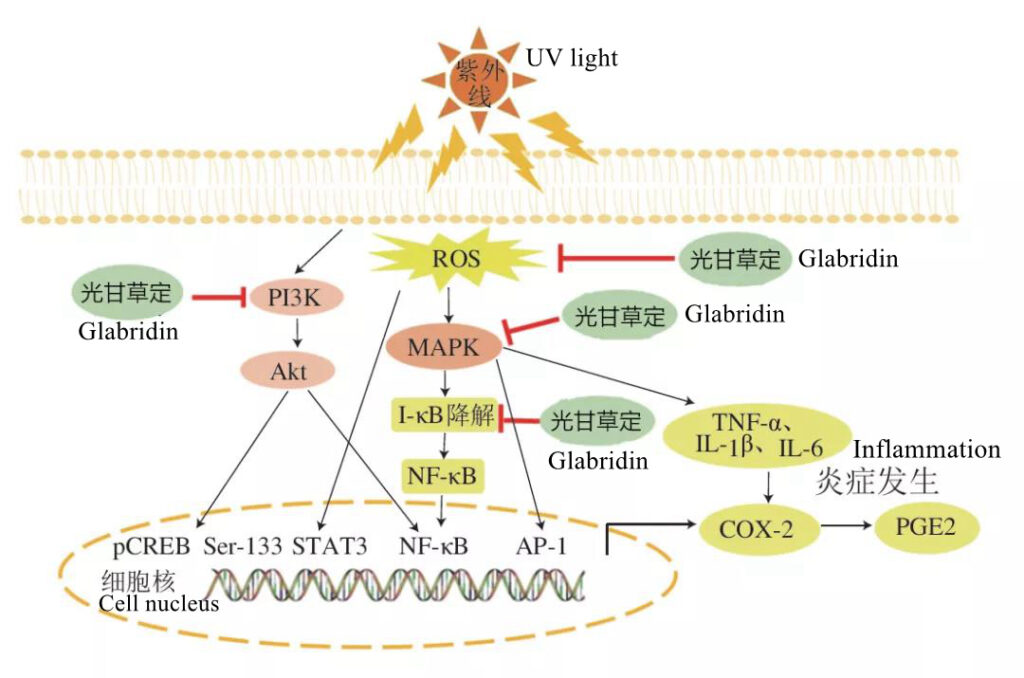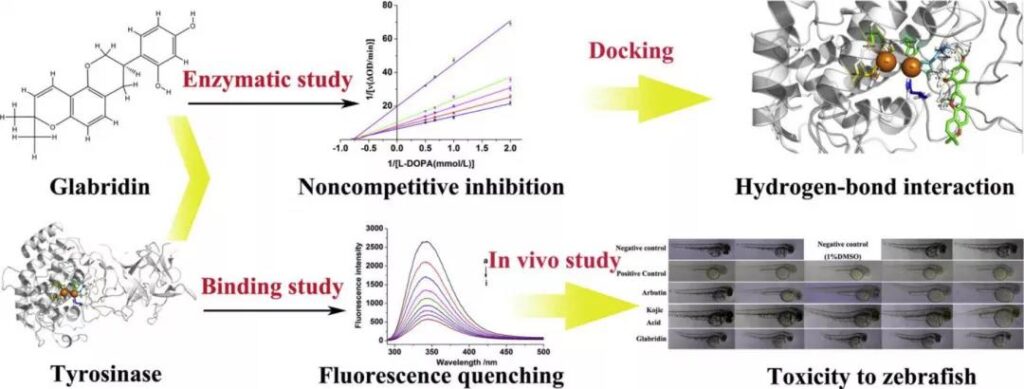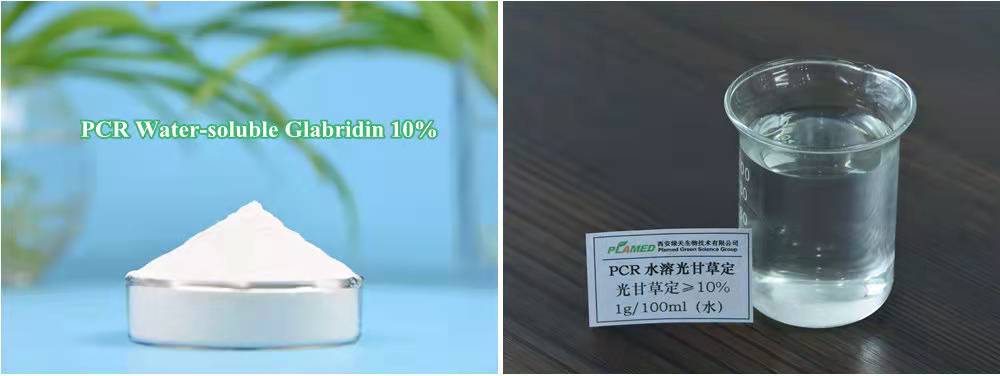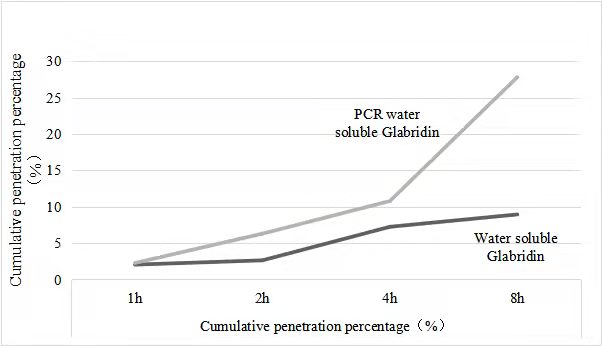All the time, skin whitening ingredients have emerged one after another., such as nicotinamide, arbutin, resveratrol, phloretin, ferulic acid, tetrahydrocurcumin, vitamin C and its derivatives, kojic acid, etc. Among these whitening ingredients, some ingredients have big names, but their effects are not outstanding. Some ingredients, such as resorcinol derivatives, fruit acid, salicylic acid, etc., have good effects, but they are irritating to the skin. Glabridin, as a potent skin whitening agent, has many benefits.
Glabridin with High Price
Among many varieties of licorice, glabridin exists in the roots and rhizomes of Glycyrrhiza glabra. It is a flavonoid bioactive substance. Glabridin only accounts for 0.1%-0.3% of roots or rhizomes; it is said that 1000kg of Glycyrrhiza glabra can only get 100g Glabridin, and 1g Glabridin is equivalent to 1g of physical gold.
Glabridin Skin Whitening Effect
The whitening mechanism of glabridin is all-around. First of all, it can inhibit tyrosinase and DOPAchrome tautomerase, which are the main force in the production of melanin. The main force is weakened, and the production of melanin naturally comes down. In addition, glabridin can relieve inflammation and inhibit inflammatory factors. Inflammation factors are one of the main factors that causes the melanocyte production. If the inflammatory factors are controlled, the production of melanin will naturally decrease. Finally, it has anti-oxidant properties. Anti-oxidation is good for skin whitening and anti-aging. The three effects are added together, and the whitening effect is naturally powerful.
Glabridin Skin Whitening Effect
The whitening mechanism of glabridin is all-around. First of all, it can inhibit tyrosinase and DOPAchrome tautomerase, which are the main force in the production of melanin. The main force is weakened, and the production of melanin naturally comes down. In addition, glabridin can relieve inflammation and inhibit inflammatory factors. Inflammation factors are one of the main factors that causes the melanocyte production. If the inflammatory factors are controlled, the production of melanin will naturally decrease. Finally, it has anti-oxidant properties. Anti-oxidation is good for skin whitening and anti-aging. The three effects are added together, and the whitening effect is naturally powerful.
Whitening Mechanism of Glabridin
- Inhibit the activity of tyrosinase and DOPAchrome tautomerase
The melanin synthesis process mainly involves three enzymes in the tyrosinase gene family, namely tyrosinase (TYR), DHICA oxidase (TRP-1), DOPAchrome tautomerase (TRP-2). Tyrosinase is the key enzyme of this reaction. TYR is involved in the production of pheomelanin and eumelanin, while TRP-2 and TRP-1 play an important role in the process of eumelanin synthesis.
The synthesis of melanin mainly undergoes two stages. The first stage is that tyrosine generates dopaquinone under the catalysis of tyrosinase. The reaction at this stage is a key step in the synthesis of melanin. Dopaquinone, as a substrate for melanin synthesis, enters the second stage of the reaction. If dopachrome undergoes tautomerism under the action of TRP-2 to be converted into dihydroxyindole-2-carboxylic acid (DHICA), eumelanin is formed under the action of TRP-1.
Therefore, inhibiting the activity of tyrosinase and TRP-2 is considered to be an important method for inhibiting pigmentation.
In 1998, Kanebo Institute of Basic Science and Cosmetics conducted a research on the effect of Glabridin on melanin production.

Figure. Inhibition effect of glabridin on tyrosinase activity of B16 melanoma cells
In an in vitro test on guinea pigs, various concentrations of Glabridin were added to the culture medium of B16 melanoma cells to determine the amount of H2O released. As a result, 0.1-10μg/mL Glabridin inhibits tyrosinase activity in a concentration-dependent manner.
The results also showed that the pigmentation on the back of guinea pigs caused by UVB was significantly less due to the continuous use of 0.5% glabridin for 3 weeks.
In the same year, Kose also conducted a research on the effect of glabridin on melanin production and TRP-2.
In an in vitro experiment, Glabridin inhibits the activity of TRP-2 at very low concentrations, and inhibits the activity of TRP-2 in a concentration-dependent manner.

Figure. Inhibitory effect of glabridin on TRP-2 activity in B16 melanocytes
- Anti-inflammation
Post-inflammatory pigmentation is an obvious manifestation of skin damage. It is an inflammatory reaction. Any damage will cause it to occur, such as friction, rubbing, wounds, dermatitis, rash, acne, ultraviolet light, laser treatment, etc.

0.05% glabridin showed a significant anti-inflammatory effect from the beginning of radiation. After 6 hours of radiation, the skin pretreated with glabridin recovered more quickly than the control group, and returned to its pre-radiation state. Thus, glabridin can reduce skin inflammation caused by UV.

- Anti-oxidation
Glabridin has good free radical scavenging and antioxidant effects in addition to tyrosinase activity inhibition. From the perspective of antioxidant, glabridin exhibits good antioxidant effects both in vivo and in vitro.
We know that exposure of the skin to ultraviolet light can cause some reactions (such as inflammation). Because the phospholipid membrane of the skin tissue is destroyed by the reactive oxygen species induced by ultraviolet light. This histological change is manifested as erythema and pigmentation.
Glabridin has a strong ability to remove DPPH and OH, and is dose-dependent. It has superior antioxidant activity in vitro.
The test result showed that glabridin has similar scavenging ability of oxygen free radical as SOD.

Glabridin Comparing to Other Skin Whitening Agents
Compare the two common whitening agents in cosmetics, nicotinamide and VC ethyl ether, and measure the absorbance to reflect the inhibitory activity of tyrosinase. The results show that the order of the magnitude of the effect of the whitening ingredients on the inhibitory rate of tyrosinase activity is: Glabridin> Nicotinamide> VC ethyl ether, of which Glabridin has the most significant skin whitening effect.

Figure. Effect of glabridin, nicotinamide and 3-0-ethyl-Lascorbic acid on tyrosinase activity
From the following picture, it can be clearly seen that arbutin and kojic acid have serious cytotoxicity while inhibiting the production of zebrafish melanin, while glabridin does not show cytotoxicity. Therefore, glabridin is much safe for topical use.

Glabridin can be used in combination with nicotinamide, VC ethyl ether, etc. It is a good way to use glabridin in combination to control the cost of the formulation and achieve safe and effective quality.

Figure. Effects of glabridin , nicotinamide,3-0-ethyl-Lascorbic acid and their blends on tyrosinase activity .in B16 melanoma cell system
Glabridin is an ester-soluble ingredient and has a very good transdermal absorption effect. However, it is inconvenient to add into water-based cosmetics. Therefore, the cyclodextrin embedding modification technology was used before. Although this technology solves the problem of water solubility, it decreases glabridin’s transdermal absorption effect.
Plamed develops PCR Glabridin, a natural water-soluble ingredient. It has higher bioavailability than ordinary glabridin. At the same concentration, the skin absorption effect of PCR Glabridin is increased by 3 times, which directly decreases the addition cost and increases the utilization.


Figure. Trend diagram of cumulative penetration percentage change over time







